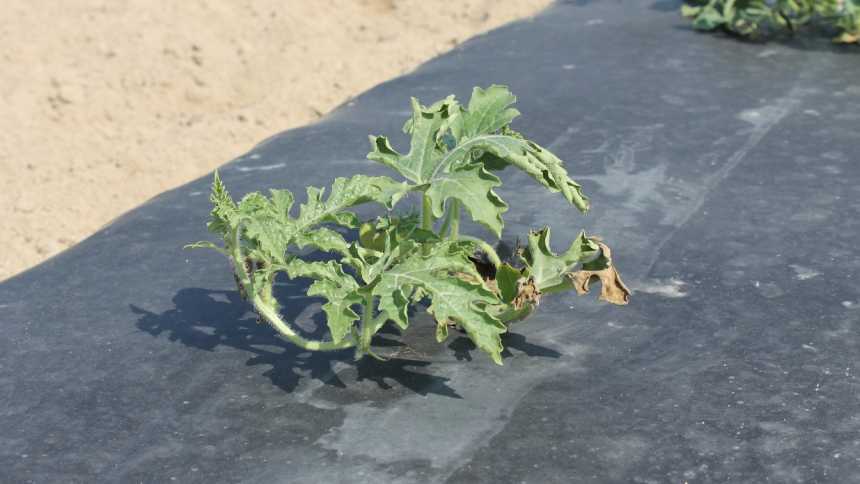Problematic Pathogens In Melons And Watermelons
Phytophthora fruit rot, Fusarium wilt, and bacterial fruit blotch — oh my. Like the Wicked Witch of the East in the movie “The Wizard Of Oz,” these diseases are bad news for melon growers in many parts of the country, and in the Mid-Atlantic region in particular.
Phytophthora And The Weather
High rainfall will leave fields with standing water. The result is conditions that favor Phytophthora blight and Phytophthora fruit rot.
Phytophthora fruit rot is difficult to combat because disease is closely tied to weather; however, cultural practices will help reduce losses. Good disease management practices include removing infected debris and diseased fruit from fields and using raised beds. Other cultural practices that improve soil drainage such as tillage, and the reduction of soil compaction are beneficial. In addition, rotate away from plants that are hosts, which include beans (snap and lima), cucurbits (pumpkin, melons, cucumbers, etc.), eggplants, and tomatoes. Use of cultural practices are important to manage this pathogen, but additional practices are needed.
Fumigants will reduce plant death; however, if only the area under the plastic is fumigated, a reservoir of pathogen inoculum can survive in-between the rows and lead to infection.
Several fungicides are registered for this disease, but when weather conditions are conducive to Phytophthora blight or fruit rot, growers are cautioned to only expect disease suppression. A partial list of fungicides include Revus (Syngenta Crop Protection), Ranman (FMC Corp.), Presidio (Valent U.S.A.), Tanos (DuPont Crop Protection), and Forum and Zampro (both from BASF). A tank mix of one of these products with copper is recommended when conditions favor Phytophthora fruit rot, although some phytotoxicity due to copper may occur. Fumigants and fungicides, used in an overall disease management program that includes cultural practices, is the best approach.
Increased Presence Of Fusarium Wilt
Fusarium wilt of watermelon is caused by Fusarium oxysporum f. sp. niveum and Fusarium wilt on muskmelon is caused by Fusarium oxysporum f. sp. melonis. Disease losses in watermelon have increased over the past 20 years, because seedless watermelon are generally less resistant than seeded cultivars and because the pathogen population has shifted to race 2, which is very damaging to watermelon.
The first symptom that appears on infected plants is wilt in a single leaf or a single vine. As the disease progresses, all vines wilt. Plants that do not die are stunted and produce fewer and smaller fruit. This disease is difficult to manage because the pathogen can survive for long periods of time in soil as chlamydospores.

This watermelon seedling is showing Fusarium wilt symptoms. The first symptom that appears on infected plants is wilt in a single leaf or a single vine.
Photo credit: Kathryne Everts
While host resistance is less effective than in the past, the use of watermelon cultivars with resistance to race 1 does confer some benefit even when race 2 is present. Long periods (ideally five years) between watermelon production in a field is also important. Likewise for cantaloupe, rotation and use of cultivars with host resistance are important to manage Fusarium wilt.
In the future, grafting may be used to manage these diseases. Now, however grafting isn’t widely used in the Mid-Atlantic region because of the expense. Planting hairy vetch or crimson clover and incorporating a green manure prior to production of watermelon reduces Fusarium wilt in some environments, but other management tactics must be implemented, as well.
Historically, no fungicides were available for use in-season; however, research was conducted with funding from the IR-4 Project that showed the use of Proline through drip irrigation lines could reduce Fusarium wilt in watermelon early in the season. Recently, Bayer CropScience received a supplemental label for drip irrigation application of Proline on water-melon and cantaloupe in some states. This will be a good additional tool for watermelon and melon growers to add to their disease management programs.
A Recurring Problem: Bacterial Fruit Blotch
There are many other diseases that are important in the Mid-Atlantic region, such as downy mildew, gummy stem blight, and anthracnose. However, in the past few years, bacterial fruit blotch (BFB) has become a recurring problem and increased in frequency.
BFB on watermelon and cantaloupe is primarily spread on seed, although it can overwinter for a year in soil.
The main challenge in managing BFB is that symptoms may not be observed until just before harvest. Yet management of BFB needs to be initiated in transplant production to minimize the chance of infected transplants. In the field, sprays are only effective when applied early in the season. This is because fruit are only susceptible when the plants are flowering, and up to three weeks later. At that time fruit develop a waxy layer that protects them from infection.
A minimum of a two-year rotation should be followed and volunteer plants should be controlled in the rotational crop. To prepare for BFB, growers should apply copper or a combination of copper and Actigard (Syngenta Crop Protection) during early fruit development. Begin sprays before the first flower is open and continue for three weeks after flowering.
Subsequent fruit sets must also be protected. If BFB is observed in a field, those fields should be worked last in the day, to avoid spreading the disease.










